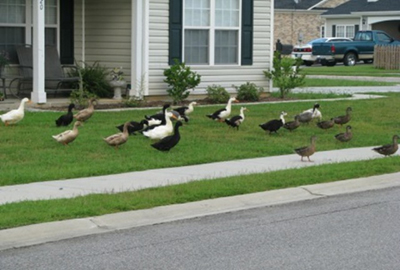Although migratory by nature, ducks, geese, and swans often choose to reside in residential stormwater ponds year-round because there are few predatory threats and they can find suitable habitat. As a result, populations of these birds can grow to the extent that they begin to cause significant property damage and become a health concern for themselves, for residents in the community, and for swimmers, surfers, and fishermen using rivers and beaches downstream.
-
Are there benefits to having waterfowl in a stormwater pond?
Very few. The most significant benefit is aesthetic and a matter of opinion. Having at least some ducks, geese, or swans in a pond does make the pond seem more natural and appealing. Also, waterfowl can be very playful and an enjoyment to watch. Otherwise, waterfowl do not provide any real management services such as controlling weeds or managing pollution. Quite the contrary, concentrated populations of these birds can cause serious property damage and water quality problems in stormwater ponds and can make aquatic weed and algae problems much worse.
-
What is so bad about waterfowl in stormwater ponds?
Large aggregations of waterfowl cause significant damage to stormwater ponds. Large groups of ducks, geese, and swans can:
- erode shorelines by trampling and feeding on shoreline plants
- destroy lawns and gardens
- introduce invasive weeds that are stuck to their feathers and carried in their digestive tracts
- deposit large volumes of feces (excrement) that increase algae and weed growth and introduce disease causing pathogens into the water that threaten the health of residents, pets, and the birds themselves
- make water muddy and cloudy as they sift through the mud for invertebrates and uproot vegetation
- become aggressive with children and pets
- create unsightly conditions when they molt, leaving feces and feathers in yards, on porches and on driveways and roads
-
How many ducks/geese is too many for a pond?
Two birds per acre of pond is a manageable number that will not result in significant property damage or water quality impairments. This number should be considered as an average because ducks are highly mobile and migratory. At certain times of the day, ducks in the community may aggregate in one area or another, and at certain times of the year (mainly the winter months) migratory birds may temporarily reside in a community's ponds. At other times, ecological pressure (competition and predation) will force the birds to disperse and move on.

-
How can we reduce the number of waterfowl in our ponds?
Stop feeding them! Although stormwater ponds provide suitable open space and water for ducks and geese, they do not usually provide adequate food. Waterfowl require a diversity of plants and invertebrates for healthy growth, and stormwater ponds do not normally have the appropriate food base to sustain large groups of waterfowl. The primary reason waterfowl aggregate in stormwater ponds is that their diet is being supplemented by humans. Before any other strategy can be employed, a community that is trying to reduce waterfowl numbers MUST curtail all feeding of birds; otherwise, other efforts will be futile.
Deterrents: There are numerous products on the market that will upset the behavior of waterfowl and encourage them to move elsewhere. These include decoys of predators and dead birds, noise making devices, motion sensing sprinklers, flashing lights, trip wires, chemical repellents, and more. These devices are useful in small scales, but may not produce the desired level of control for the entire pond or throughout the community.
Special note: Read the directions on these products carefully. The manufacturer may provide hints for increasing the effectiveness of the product, such as moving predator decoys each week to ensure that the birds do not get used to a static decoy.
Trapping: In some instances stopping feeding and deterrents are not encouraging the birds to find a new home. If this is the case, the community may need to have the birds removed by a professional. The community should contact a licensed nuisance wildlife control operator to have the birds trapped or dispatched. Even though these birds may seem domesticated, they are still considered by the federal government and the State to be protected migratory animals, and residents may be in violation of the law if they trap or dispatch birds out of season and without license. A licensed nuisance wildlife control operator can work with the state to acquire any necessary permits for the removal of large groups of nuisance waterfowl. Consult the SC Department of Natural Resources list of Nuisance Wildlife Control Operators for a professional near you.
-
Are there any laws about having or stocking ponds with waterfowl?
Yes, but they are determined at the local level. Some counties and municipalities have ordinances that prohibit feeding waterfowl or creating other conditions that result in the aggregation of waterfowl in stormwater ponds. These ordinances vary from county to county and city to city, so it is important for your community to check with the local government to find out if there are restrictions on feeding waterfowl. Some municipalities and counties have no such ordinances. Some HOAs have taken the next step and made feeding waterfowl a violation punishable by a fine, so check your HOA's bylaws as well.

